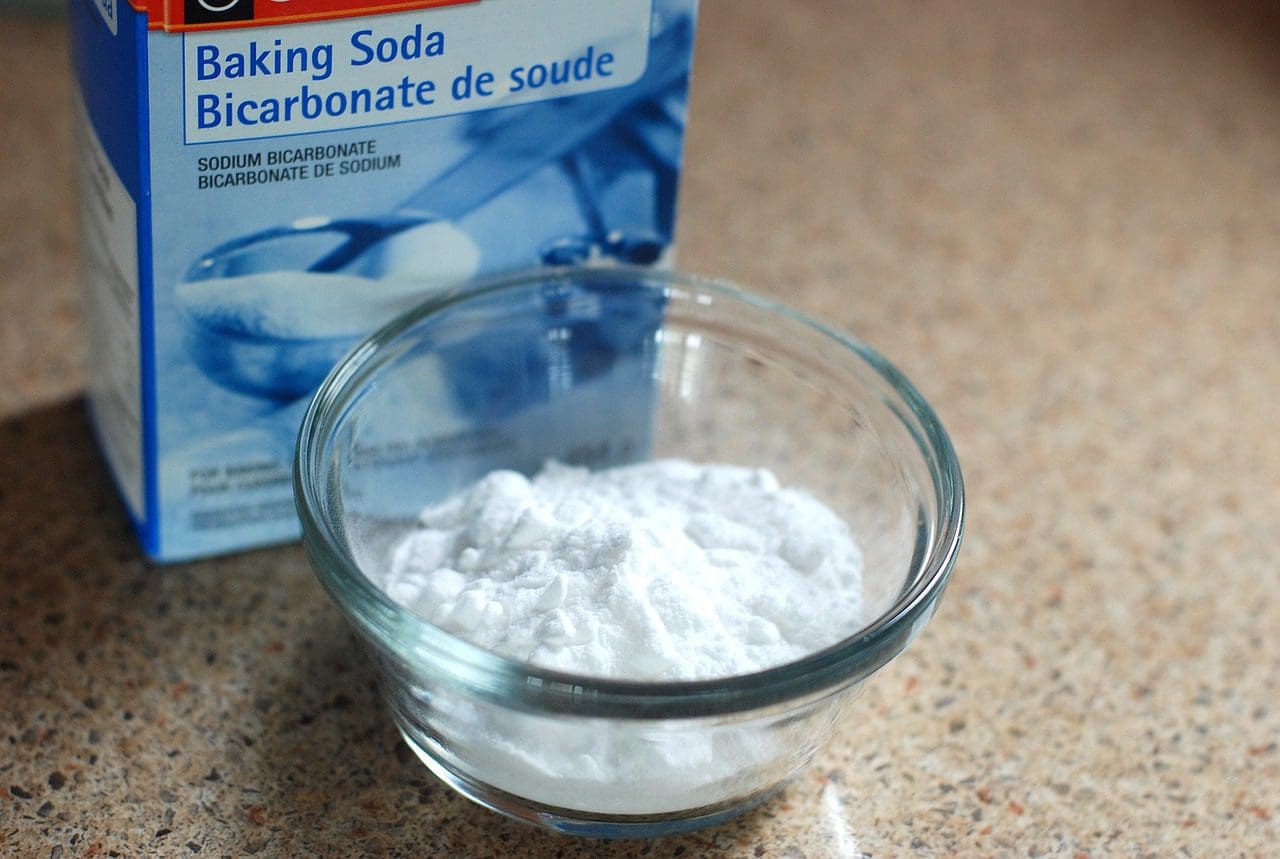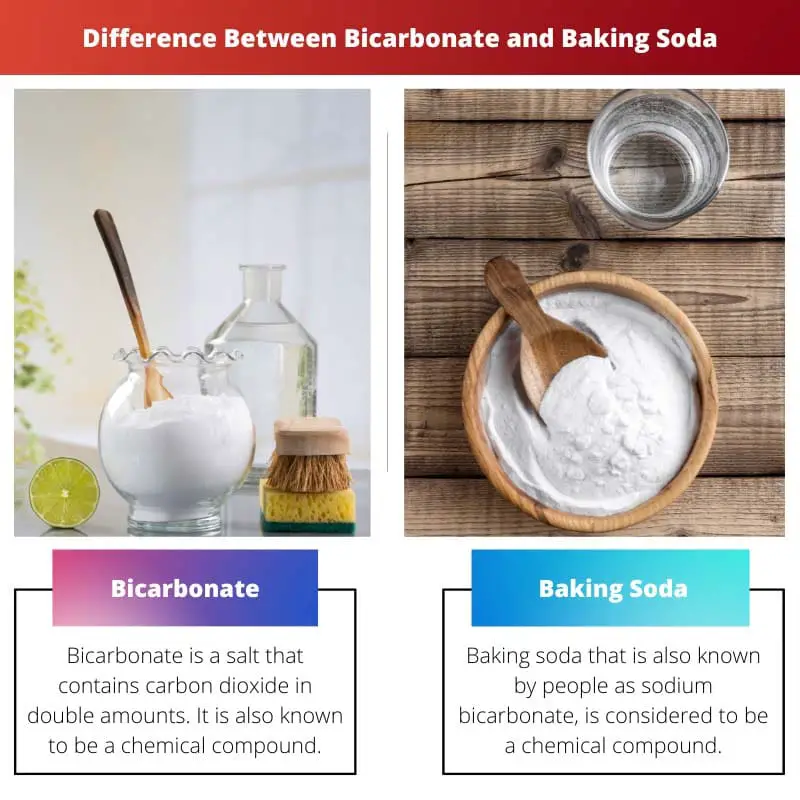A chemical compound is a very well-known term in chemistry that is described as having identical molecules that are responsible for its formation.
Bicarbonate and baking soda are also widely known two chemical compounds which have multiple uses. Both Bicarbonate and baking soda should be consumed in the suggested amount for better protection of the body.
Key Takeaways
- Bicarbonate is an anion (HCO3-) and a component of baking soda, while baking soda (sodium bicarbonate) is a chemical compound (NaHCO3).
- Baking soda is used in various household applications such as cleaning, cooking, and personal care, whereas bicarbonate regulates pH levels in the body.
- Baking soda reacts with acids to produce carbon dioxide, making it useful as a leavening agent in baking.
Bicarbonate vs Baking Soda
Bicarbonate is an intermediate form in the deprotonation of carbonic acid. It requires an acid and a liquid to become activated and helps baked goods rise. Baking soda a fine white powder that is just pure sodium bicarbonate. It is simply an alternate term for bicarbonate.

Bicarbonate is a salt that contains carbon dioxide in double amounts. It is also known to be a chemical compound. The term bicarbonate is associated especially with organic chemistry and the scientific formula of bicarbonate is HCO3-.
Bicarbonate is also known as Bicarbonate Ion, 71-52-3 Bicarbonate, etc. It is considered to have an important role in the pH buffering system.
Baking soda that is also known by people as sodium bicarbonate, is considered to be a chemical compound that has numerous domestic uses. It has a crystalline appearance with pure white color.
Baking soda contains 0% of nutrients like protein, vitamins, calories, etc. Baking soda is used in food as well as to turn milk sour.
Comparison Table
| Parameters Of Comparison | Bicarbonate | Baking Soda |
|---|---|---|
| Scientific name | The scientific formula that is used for Bicarbonate is HCO3-. | The scientific formula that is used for baking soda is NaHCO3. |
| Other names | The other names used for Bicarbonate are bicarb, natrium hydrogen carbonate, and natron. | The other names used for baking soda are bicarbonate of soda and sodium bicarbonate. |
| Composition | Bicarbonate is the composition of carbon, hydrogen, and oxygen atoms. | Baking soda is the composition of carbon, sodium, hydrogen, and oxygen atoms. |
| Acidity (pKa) | The pKa value of acid contained by bicarbonate is 10.3. | The pKa value of acid contained by baking soda is 6.351. |
| Uses | The uses of Bicarbonate involve treating sour stomach, curing heartburn, helping in indigestion, etc. | The uses of baking soda involve freshening the air, odor elimination, teeth whitening, mouthwash, etc. |
What is Bicarbonate?
Bicarbonate is a by-product produced during the dissociation of carbonic acid. In inorganic chemistry, bicarbonate is denoted with the chemical formula HCO3 and it acts as an anion, which means it has a negative charge over it.
It has a trigonal planar atomic structure. As it is apparent from its chemical formula, bicarbonate comprises a single carbon atom linked with three oxygen atoms along with a hydrogen atom attached to one of the oxygen atoms.
Molar mass of bicarbonate ions is about 61 g/mol. Metabolism of the human body creates Bicarbonate as a byproduct.
The process of formation of bicarbonate initiates from a combination of Carbon Dioxide(CO2) and Water(H2O) leading to the formation of carbonic acid (H2CO3), which further dissociates into Hydrogen ions(H+) and bicarbonate(HCO3).
Thus, bicarbonate acts as the primary buffer in the body, which absorbs the excessive hydrogen ions and also releases these ions when there is a shortage.
It regulates the pH levels of the body and maintains balance. Hence, it helps to manage acid-base homeostasis in the body. Bicarbonate is suggested to be consumed in small amounts and for a short period.
The excessive amount of bicarbonate can cause vomiting and diarrhea that can lead to serious conditions.

What is Baking Soda?
Baking soda is a chemical compound with the chemical formula NaHCO3. It is also known as Sodium bicarbonate.
The atomic structure of sodium bicarbonate is trigonal planar and comprises one carbon atom in the center linked to three oxygen atoms with one hydrogen and one sodium atom.
The process of formation of baking soda includes the combination of a sodium cation(Na+) and bicarbonate anion(HCO3-). Sodium bicarbonate tastes salty and is a white crystalline solid with a molar mass of about 84 grams per mole.
It is soluble in water. It is vastly used for baking purposes also. For instance, baking soda is used to make delicious fritters, bread, and cakes as it acts as a leavening agent also.
It is also used as an anti-agent against rust on metallic surfaces. In the agricultural sector, baking soda is used to restrict the growth of fungi on the leaves of plants.
It is also used as a medicine to treat acid formation caused due to indigestion in the human body. On reacting with acids, sodium bicarbonate forms Carbon Dioxide gas as a product.
Sodium bicarbonate dissociates in sodium carbonate(Na2Co3), water(H2O), and Carbon dioxide(CO2), reaching a temperature of 100 degrees celsius.
Hence, sodium bicarbonate or baking soda is a chemical compound with a vast field of applications and uses.

Main Differences Between Bicarbonate and Baking Soda
- Bicarbonate contains fluid-build-up properties and people can suffer from swelling by consuming excessive amounts, while Baking soda is commonly used for treating swelling by mixing in lukewarm water.
- The scientific formula that is used to denote Bicarbonate is known as HCO3-. On the other hand, the scientific formula for baking soda is NaHCO3.
- Bicarbonate is used to treat diseases related to the stomach and heart, while baking soda works as a cleaner and freshener.
- Bicarbonate is considered to be poisonous if taken in excessive amounts and suggested to be out of reach of children. On the other hand, baking soda is used in food, but very little amount.
- Some of the names bicarbonate is also known as natron and bicarb. On the other hand, baking soda is known as sodium bicarbonate.

